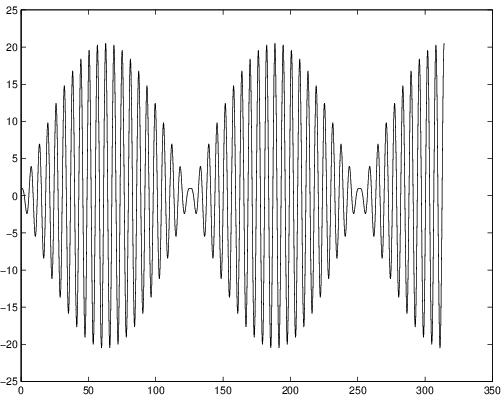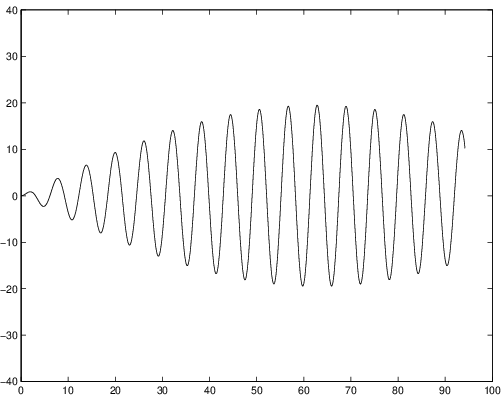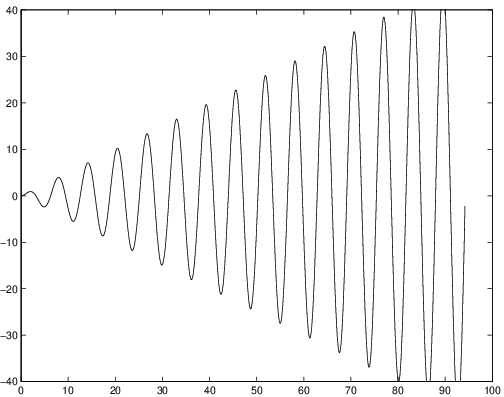Periodic Forcing
A linear second order differential equation is periodically forced if it has the form where is periodic in time; that is, for some period . The simplest kind of forcing is sinusoidal forcing, that is, where is the forcing frequency and is a phase. We simplify the discussion by choosing the phase so that and .
Suppose, in addition, that the homogeneous equation itself has periodic solutions with internal frequency . Such a differential equation is ; by rescaling time we can assume that . Thus, the homogeneous equation is and the forced equation is
where .We focus on three features of solutions to this equation.
- Generally, solutions to (??) are quasiperiodic having two frequencies — just like the torus solutions mentioned in Section ??.
- When the forcing frequency is near the internal frequency, the solution has beats.
- Resonance occurs when the forcing frequency equals the internal frequency.
The Periodically Forced Undamped Spring
One of the simplest examples of a model differential equation with both a forcing frequency and an internal frequency is the periodically forced undamped spring.
The motion of a forced undamped spring is described by the spring equation given in Chapter ??, (??) with . To simplify the computations, we set the mass to be and suppose that the spring constant is . Then, with periodic forcing , we obtain the differential equation (??).
Closed Form Solutions to (??) by Undetermined Coefficients
We can apply the method of undetermined coefficients to solve (??), but there are two cases: and .
The Case
We use undetermined coefficients to find a particular solution to the inhomogeneous equation (??). The forcing term is a solution to the differential equation
Thus the annihilator of is . The eigenvalues of the homogeneous equation associated to (??) are and the eigenvalues of are . Thus when we can use undetermined coefficients by choosing the general solution to (??) as the trial space for (??). So we set Next, substitute into (??), obtaining This equality holds when Since the general solution of the homogeneous equation associated to (??) is the general solution to (??) is when .The Case
When the roots of and both equal . Thus, to use undetermined coefficients, we must first find the general solution to This solution is On setting the solutions to the homogeneous equation associated to (??) to zero (that is, on setting ), we find that the trial space for (??) is: Substituting into (??) yields: Therefore, and , and a particular solution of (??) is The general solution can be written as
To summarize: the general closed form solution to (??) is
Types of Solutions to (??)
We use the closed form solution (??) to (??) to identify three different types of solutions: quasiperiodic two-frequency motion, beats, and resonance.
Quasiperiodic Two Frequency Motion
In our discussion we now specify initial conditions. In particular, the solution to (??) with initial conditions and is:
In particular, when , the solution (??) is just a linear combination of two periodic functions with different frequencies: In this way it is straightforward to see that the motion is quasiperiodic with two frequencies.When is far from , the solution is very close to the solution to the undamped unforced spring equation. Indeed, note that when the frequency is large, then it follows from (??) that is approximately equal to . See Figure ??.
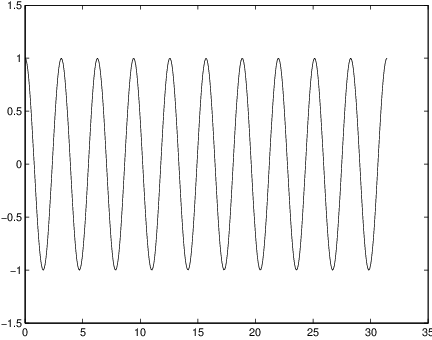
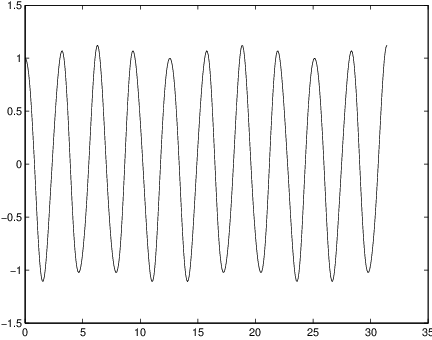
Beats
Using the trigonometric identity we find that the solution is approximately
when is close to . Note that the first sine term on the right hand side of (??) has period about while the second sine term has a large period of . For example, when , this fact leads to periodic behavior of period about and a modulation of period about . See Figure ??.Resonance
When it follows from (??) that every solution to (??) is unbounded as goes to infinity. This phenomenon is called resonance, and is due to the fact that the internal frequency is the same as the forcing frequency. The solution to (??) for is shown in Figure ?? (right). Resonance shows that when the forcing frequency equals the internal frequency, the forcing amplifies the internal dynamics.
Note that when is close to the solution follows the solution for for some length of time. See Figure ?? where the solutions for and are given. But it is only when exactly that unbounded growth or resonance actually occurs while the nearby solution has long term modulation or beats.
Exercises
In Exercises ?? – ?? decide whether or not beats or even resonance occurs in the given differential equations.
